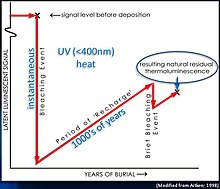Thermoluminescence Dating. Thermoluminescence can be used to date materials containing crystalline minerals to a specific heating event. This is useful for.
Table of contents
- Citing this material
- Thermoluminescence dating - Wikipedia
- Thermoluminescence dating
- Navigation menu
- online dating tips for men over 40!
- Beer-lovers shop!
- User Comments.
- popular taiwan dating app!
- Dating Techniques - Thermoluminescence Dating!
Archaeologies of the Greek Past - Home schedule requirements assessment course members message board micro-projects Joukowsky Institute for Archaeology. Thermoluminescence can be used to date materials containing crystalline minerals to a specific heating event.
This is useful for ceramics, as it determines the date of firing, as well as for lava, or even sediments that were exposed to substantial sunlight. These crystalline solids are constantly subjected to ionizing radiation from their environment, which causes some energized electrons to become trapped in defects in the molecular crystal structure.
Citing this material
An input of energy, such as heat, is required to free these trapped electrons. A non-negligible part of materials which ceramic is usually made of like quartz and feldspars is thermoluminescent: When these materials are heated to several hundreds of Centigrade degrees, electrons are evicted from trap states and energy is emitted in form of light: Heating ceramic in a furnace resets TL accumulated by clay and other materials; from this time on, TL begins growing again as time passes; the more concentrated radioactivity where ceramic is, the quicker TL grows.
Since measured TL depends on time of exposition to natural radiations but also on the intensity of these radiations, to achieve a precise dating we need information about radioactivity of the area where the object was found.
During TL analysis, the sample is reheated by a controlled heating process, so the energy is released in the form of light thermoluminescence as the electrons escape. The amount of light produced is measuered by a photomultiplier.
Thermoluminescence dating - Wikipedia
The result is a glow curve showing the photon emission in function of the heating temperature:. Because this accumulation of trapped electrons begins with the formation of the crystal structure, thermoluminescence can date crystalline materials to their date of formation; for ceramics, this is the moment they are fired.

The major source of error in establishing dates from thermoluminescence is a consequence of inaccurate measurements of the radiation acting on a specimen. The paleodose is the absorbed dose of natural radiation accumulate by a sample. This paleodose is determined from the TL signal measured by heating sample at a constant rate. The accuracy of the linearity in heating sample is crucial to have a precise measure.
Thermoluminescence dating
The result of this measure is, as described above, a glow curve. Three different types of glow curve can be distinguished: Cyanohydrins to Departments of philosophy: Thermoluminescence dating is very useful for determining the age of pottery.
Electrons from quartz and other minerals in the pottery clay are bumped out of their normal positions ground state when the clay is exposed to radiation. This radiation may come from radioactive substances such as uranium , present in the clay or burial medium, or from cosmic radiation. The longer the exposure to the radiation, the more electrons that are bumped into an excited state, and the more light that is emitted upon heating.
Navigation menu
The process of displacing electrons begins again after the object cools. Scientists can determine how many years have passed since a ceramic was fired by heating it in the laboratory and measuring how much light is given off. Thermoluminescence dating has the advantage of covering the time interval between radiocarbon and potassium-argon dating, or 40,—, years.